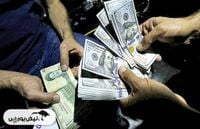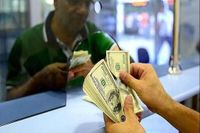As of April 12, 2025, the Iranian currency market is experiencing notable fluctuations amid ongoing diplomatic discussions between Iran and the United States. The price of the American dollar has seen a significant decline, dropping to approximately 97,000 Tomans in the Tehran free market. This decrease comes as both nations prepare for new negotiations set to take place in Oman, which have sparked hopes among traders for a potential easing of tensions.
According to reports from various financial news outlets, the price of each banknote of the American dollar in Tehran has reached around 97,000 Tomans today. This shift is particularly interesting as it occurs against the backdrop of the upcoming talks, which are expected to influence the market significantly. Meanwhile, the official exchange rate for the dollar at the Iranian Exchange Center has been reported at 70,833 Tomans, reflecting a slight drop of 71 Tomans compared to the previous trading day.
In contrast, the euro is experiencing a remarkable increase. The euro exchange rate in the exchange center surged by 1,955 Tomans today, reaching 80,237 Tomans for the first time ever crossing the 80,000 Tomans mark. This rise in the euro's value, alongside the decline in the dollar, suggests a potential shift in market dynamics, possibly influenced by changing economic policies or regional developments.
Furthermore, the UAE Dirham has also been affected by these market movements. Today, the Dirham is trading at 19,287 Tomans in the official market, indicating a stable yet fluctuating pattern similar to that of the dollar. On the other hand, the Russian Ruble has shown resilience, with its exchange rate rising to 847 Tomans, potentially due to ongoing trade settlements between Iran and Russia.
Market analysts have pointed out that the Iranian currency market is highly sensitive to political developments and international negotiations. The recent decrease in the dollar's price in the free market, juxtaposed with the euro's rise, illustrates a complex landscape that traders must navigate. This scenario emphasizes the need for clarity in the pricing mechanisms and the positions of currency policymakers.
Despite the dollar's decline, market sentiment remains cautious. Traders are exhibiting a reluctance to engage in large transactions, reflecting uncertainty about the outcomes of the upcoming negotiations. The psychological barrier of 100,000 Tomans has helped to stabilize the dollar's value, preventing it from falling further.
As the Iranian market heads into a new week, the fluctuations and trends observed over the past few days suggest a delicate balance between optimism and caution. The dollar, which initially surged into the tenth corridor at the beginning of the week, faced corrections following news of indirect negotiations between Iran and the U.S. in Muscat. These developments have not only impacted the dollar's price but have also led to a complex interplay of currency values across the board.
In addition to the dollar and euro, the price of Tether in the domestic market has fluctuated between 96,000 Tomans and 100,250 Tomans, currently standing at 97,200 Tomans. Analysts suggest that Tether's recent performance, which saw it trade below the dollar, reflects the ongoing pressures resulting from the political landscape and the global dollar's valuation.
Looking ahead, experts believe that the Iranian currency market is at a critical juncture. Two key support levels have been identified for the dollar: the floor of the ninth corridor and the floor of the tenth corridor. Maintaining these levels is crucial for preventing deeper corrections. Should these support levels fail, the dollar could potentially decline further, leading to more significant market adjustments.
As traders keep a close eye on the negotiations set to unfold in Oman, the outcome could dictate the direction of the dollar and other currencies in the Iranian market. If the discussions yield positive results, there is a possibility that the dollar may retreat to the first channel of the ninth corridor. Conversely, if the talks do not progress favorably, the market might witness a resurgence in the dollar's value.
In summary, the Iranian currency market is currently a reflection of the broader geopolitical landscape, with the dollar's fluctuations and the euro's rise signaling both opportunity and risk for traders. As the situation develops, it will be essential for market participants to stay informed and prepared for potential shifts in currency values driven by diplomatic outcomes.









